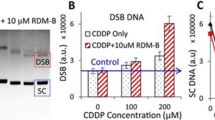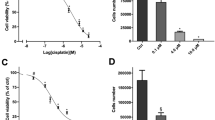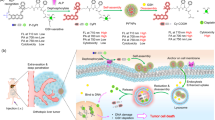Abstract
AQ4N is a bioreductive drug that can significantly enhance the anti-tumour effect of radiation and cyclophosphamide. The aim of this study was to examine the ability of AQ4N to potentiate the anti-tumour effect of cisplatin and to compare it to the chemopotentiation effect of tirapazamine. In the T50/80 murine tumour model, AQ4N (50–100 mg/kg) was administered 30 min, 2.5 or 6 h prior to cisplatin (4 mg/kg or 8 mg/kg); this produced an anti-tumour effect that was approximately 1.5 to 2 times greater than that achieved by a single 4 or 8 mg/kg dose of cisplatin. Tirapazamine (25 mg/kg) administered 2.5 h prior to cisplatin (4 mg/kg) resulted in a small increase in anti-tumour efficacy. AQ4N was also successful in enhancing the anti-tumour effect of cisplatin in the SCCVII and RIF-1 murine tumour models. This resulted in an increased cell kill of greater than 3 logs in both models; this was a greater cell kill than that observed for tirapazamine with cisplatin. Combination of cisplatin with AQ4N or tirapazamine resulted in no additional bone marrow toxicity compared to cisplatin administered alone. In conclusion, AQ4N has the potential to improve the clinical efficacy of cisplatin. © 2001 Cancer Research Campaign http://www.bjcancer.com
Similar content being viewed by others
Article PDF
Change history
16 November 2011
This paper was modified 12 months after initial publication to switch to Creative Commons licence terms, as noted at publication
References
Dorie MJ and Brown JM (1993) Tumour-specific schedule dependent interaction between tirapazamine (SR4233) and cisplatin. Cancer Res 53: 4633–4636
Dorie MJ and Brown JM (1997) Modification of the anti-tumour activity of chemotherapy drugs by the hypoxic cytotoxic agent tirapazamine. Cancer Chemother Pharmacol 39: 361–366
Friery OP, Gallagher R, Murray MM, Galligan ES, Hughes CM, McIntyre IA, Patterson LH, Hirst DG and McKeown SR (2000) Enhancement of the antitumour effect of cyclophosphamide by the bioreductive drugs AQ4N and Tirapazamine. Br J Cancer 82: 1469–1473
Gervot L, Rochat B, Gautier JC, Bohnenstengel F, Kroemer H, de Berardinis V, Martin H, Beaune P and de Waziers I (1999) Human CYP2B6: expression, inducibility and catalytic activities. Pharmacogenetics 9: 295–306
Hejmadi MV, McKeown SR, Friery OP, McIntyre IA, Patterson LH and Hirst DG (1996) DNA damage following combination of radiation with the bioreductive drug AQ4N: possible selective toxicity to oxic and hypoxic tumour cells. Br J Cancer 73: 499–505
Holden SA, Teicher BA, Ara G, Herman TS and Coleman CN (1992) Enhancement of alkylating agent activity by SR4233 in the FSaIIC murine fibrosarcoma. J Natl Cancer Inst 84: 187–193
Horsman MR, Evans JW and Brown JM (1984) Enhancement of melphalan – induced tumour cell killing by misonidazole: an interaction of competing mechanisms. Br J Cancer 50: 305–316
Kennedy KA (1987) Hypoxic cells as specific drug targets for chemotherapy. Anticancer Drug Des 2: 181–194
McAleer JJA, McKeown SR, MacManus MP, Lappin TRJ and Bridges JM (1992) Hypobaric hypoxia: a method for testing bioreductive drugs in vivo. Int J Radiat Oncol Biol Phys 23: 551–555
McKeown SR, Hejmadi MV, McIntyre IA, McAleer JJA and Patterson LH (1995) AQ4N: an alkylaminoanthraquinone N-oxide showing bioreductive potential and positive interaction with radiation in vivo. Br J Cancer 71: 76–81
McKeown SR, Friery OP, McIntyre IA, Hejmadi MV, Patterson LH and Hirst DG (1996) Evidence for a therapeutic gain when AQ4N or tirapazamine is combined with radiation. Br J Cancer 74: Suppl. XVII, S39–S42
Moore JV (1988) The dynamics of tumour cords in an irradiated mouse mammary carcinoma with a large hypoxic cell component. Jpn J Cancer Res 79: 236–243
Overgaard J, Grau C, Lindegaard JC and Horsman MR (1991) The potential of using hypothermia to eliminate radioresistant hypoxic cells. Radiother Oncol 20: 113–116
Patterson LH (1993) Rationale for the use of aliphatic N-oxides of cytotoxic anthraquinones as prodrug DNA binding agents: a new class of bioreductive agent. Cancer Metast Rev 12: 119–134
Raleigh SM, Wanogho E, Burke MD, McKeown SR and Patterson LH (1998) Involvement of human cytochrome P450 (CYP) in the reductive metabolism of AQ4N, a hypoxia activated anthraquinone di-N-oxide prodrug. Xenobiotica 11: 115–1122
Siemann DW and Hinchman CA (1998) Potentiation of cisplatin activity by the bioreductive agent tirapazamine. Radiother Oncol 47: 215–220
Smith PJ, Blunt NJ, Desnoyers R, Giles Y and Patterson LH (1997) DNA topoisomerase II dependent cytotoxicity of alkylaminoanthraquinones and their N-oxides. Cancer Chemother Pharmacol 39: 455–461
Till JE and McCulloch EA (1961) A direct measurement of the radiation sensitivity of normal mouse bone marrow cells. Radiat Res 14: 213
Twentyman PR (1976) Comparative chemosensitivity of exponential-versus-plateau phase cells both in vitro and in vivo. Cancer Treat Rep 60: 1719–1722
Twentyman PR, Brown JM, Gray JW, Franko AJ, Scoles MA and Kallman RF (1980) A new mouse tumour model system (RIF-1) for comparison of end-point studies. J Natl Cancer Inst 64: 595–604
United Kingdon Co-ordinating Committee on Cancer Research(U.K. C. C. C. R) (1998) Guidelines for the welfare of animals in experimental neoplasia (second edition. Br J Cancer 77: 1–10
Author information
Authors and Affiliations
Rights and permissions
From twelve months after its original publication, this work is licensed under the Creative Commons Attribution-NonCommercial-Share Alike 3.0 Unported License. To view a copy of this license, visit http://creativecommons.org/licenses/by-nc-sa/3.0/
About this article
Cite this article
Gallagher, R., Hughes, C., Murray, M. et al. The chemopotentiation of cisplatin by the novel bioreductive drug AQ4N. Br J Cancer 85, 625–629 (2001). https://doi.org/10.1054/bjoc.2001.1975
Received:
Revised:
Accepted:
Published:
Issue date:
DOI: https://doi.org/10.1054/bjoc.2001.1975
Keywords
This article is cited by
-
Combinatory anti-tumor activities of 1,4-bis[2-(dimethylamino)ethylamino]-5,8-dihydroxyanthracene-9,10-dione (AQ4) and temsirolimus against colorectal cancer cells
Journal of Cancer Research and Clinical Oncology (2023)
-
Pharmacokinetics of TH-302: a hypoxically activated prodrug of bromo-isophosphoramide mustard in mice, rats, dogs and monkeys
Cancer Chemotherapy and Pharmacology (2012)
-
Bioreductive GDEPT using cytochrome P450 3A4 in combination with AQ4N
Cancer Gene Therapy (2003)



